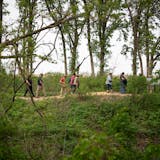DULUTH - In a zigzag staircase at a downtown park, artists are in the final stages of creating a vibrant mural to memorialize an Ojibwe leader who is key to Duluth's origin story.
The first brushstrokes for the Chief Buffalo Memorial Mural started three years ago with a recreation of a pictograph the Madeline Island-based leader carried on his seminal trip to Washington, D.C., more than 160 years ago. It was intended to be a one-wall tribute. It's now grown to include nearly a dozen.
"What would stop us from painting all of this?" lead artist Moira Villiard said she wondered at the time.
Nothing, really. Though it would require a lot of behind-the-scenes effort — paperwork, phone calls, fundraising. In addition to base money from Zeitgeist Arts, a local community-based nonprofit, Villiard estimates that she has raised upwards of $100,000.
The walls are adorned with maps, historical scenes, aquatic life and beadwork patterns along a staircase that links Gichi-Ode' Akiing Park and the Lakewalk adjacent to Lake Superior. It will be unveiled Sept. 14.
"It catches your eye," said Lisa Ronnquist, who passes the mural on her way to Lake Superior, where she prays daily. During a recent visit she pointed out a loon.
"That's my clan," she said.
Duluth's Indigenous Commission in 2018 renamed Lake Place Park as Gichi-Ode' Akiing, Ojibwe for "A Grand Heart Place." Zeitgeist Arts approached the commission about doing more at the park to acknowledge local Anishinaabe history, and Villiard was hired to lead the project. She chose Chief Buffalo as the subject.
![Three weeks ago, Octavio Rodriguez switched from making transmission parts to casting parts for hospital bed brake assemblies at Twin City Die Castings. ] GLEN STUBBE • glen.stubbe@startribune.com Thursday, April 9, 2020 How employee-owned Twin City Die Casting, which just laid off 40 production workers of its 250 employees in what was supposed to be a good year, is trying to accelerate its pivot to growing medical parts business for ventilators, hospital beds, etc as it copes with instan](https://arc.stimg.co/startribunemedia/WNZYKGTZ5IYMUCO3KI5TR3N7WI.jpg?&w=80&ar=1:1&fit=crop)
djoles@startribune.com As boaters flock to Minnesota lakes and rivers this holiday weekend for the unofficial kick-off to the boating season, they'll face more inspections in and out of the water as local cities and counties ramp up their work to stop the spread of invasive species. Across the metro, more boat accesses will be staffed by watercraft inspectors thanks to $10 million funneled to county government programs this year, up from $4.5 million the state allocated last year. ORG XMIT: MIN1505222156290209 ORG XMIT: MIN1506021218440580](https://arc.stimg.co/startribunemedia/34QSKO44B2XKVNUZCO5SLJQSLY.jpg?&w=80&ar=1:1&fit=crop)

